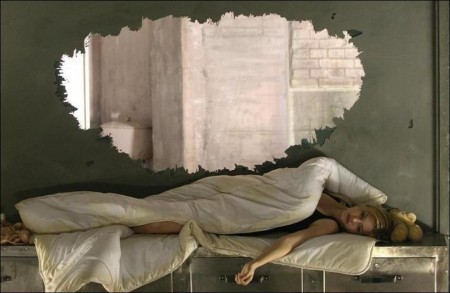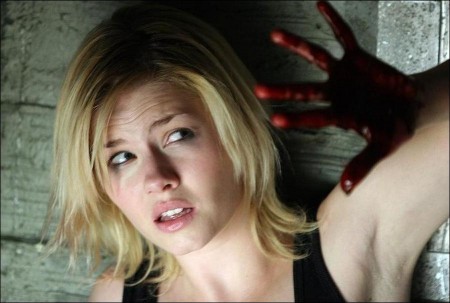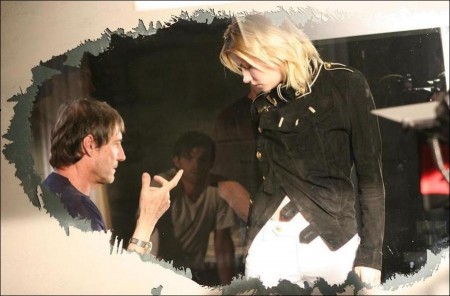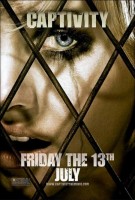Top cover girl and fashion model, Jennifer Tree (Elisha Cuthbert) has it all – beauty, fame, money and power. Her face appears on covers of hundreds of magazines. At the top of her game, Jennifer is America’s sweetheart. She is loved and adored and sought after. Everyone wants her. But someone out there has been watching and waiting.
Someone wants her in the worst way. Out alone at a charity event in Soho, Jennifer is drugged and taken. Held captive in a cell, Jennifer is subjected to a series of terrifying, life-threatening tortures that could only be conceived by a twisted, sadistic mind.
Inspired by the fact that over 850,000 people are reported missing every year in the United States, many of whom are never seen again, CAPTIVITY, follows the story of one woman who is abducted and tortured, held against her will in a place where days turn into weeks. Her will to escape and survive is challenged every moment by a maniac’s desire to demoralize innocent victims and play out his sick game that has been played many times before Jennifer was taken.
A combination of “Saw” and “Hostel” meets “Silence of the Lambs,” CAPTIVITY is a psychological thriller/horror film that shows us the true terror of the crimes of abduction and confinement that are committed every day by serial killers and psychopaths at large.
Directed by acclaimed filmmaker Roland Joffe, CAPTIVITY delves deeply into the minds of both captor and victim with a fresh and terrifying view of this epidemic horror. Being released this summer in theatres nation-wide, CAPTIVITY has been called one of the most controversial films of the year. It’s a disturbing and raw, yet classy and thought provoking film which will leave you terrified, and looking over your shoulder.
About the Production
For the first US and Russian co-production, RAMCO producers Leonid Minkovski and Serge Konov knew the burden to impress was looming above them and the right script would be critical. A few months after veteran Hollywood producer Mark Damon visited them in Russia in September of 2004, he sent them the script of Captivity which was first brought to Damon’s attention by producer and longtime friend, Gary Mehlman.
After being in the film industry for over 50 years and credited with having invented the foreign sales business, Damon was intrigued by the possible Russian collaboration. “I knew that up till that point this had not been done, and was impressed with the three principals I met: Leonid Minkovski, Valery Chumak and Serge Konov,” said Damon.
Always looking for the next challenge in an already illustrious career, Damon saw this opportunity as a new frontier. “I realized that there were great possibilities here for an inroad into Russia for American producers, and I thought this would be a challenge to be the first.” Staying true to his independent roots although always striving for the mainstream, Mr. Damon saw the potential in Captivity to be more than just another thriller, and RAMCO’s Russian co-producers agreed as did Academy Award nominated director, Roland Joffe.
The choice of Joffe as director certainly seemed unconventional at the time as he is best known for dramatic films such as the Academy-Award nominated The Killings Fields and the critically acclaimed The Mission. Konov speaking of Joffe reflects, “I realized that it could be a great chance for us to produce a very unusual genre movie.” Minkovski agreed. “Roland Joffe involved as a director made me look at this script a little bit different than just another horror movie, I came to realize this will be not just another scary movie, this will be a very interesting psychological thriller.”
As Joffe had never made a genre picture at that point, Damon set aside time for the both of them to watch genre film after genre film to study the techniques that were necessary. As pre-production continued on, it became clear that Joffe would indeed add a welcome complexity to the already intriguing script, and would bring with him the focus and intensity of many of his earlier films. Minkovski states, “creatively he’s an incredible director, making everybody around him, the whole crew excited,” says Leonid. “But he’s also tough… tough to work with because he has very specific wishes. And it’s really hard to fight him especially when you see the final product we’re getting, when you look at the dailies.” It was clear to the whole cast and crew that Joffe had a certain vision for the film that has become even more palpable as post-production progresses.
The story, crafted by the writer of Cellular and Phone Booth, is filled with the requisite scares and suspense, but the plot delves much deeper, probing into private fears such as isolation and separation. In regards to the depth of the plot Damon states, “I would hope the audience will take home with them a myriad of emotions: a great love story, having been frightened to death many times in the movie; having gone through a harrowing experience with Jennifer Tree; 90 to 100 minutes of tension and terror.”
The multiple facets of the characters allowed the actors to become more attached to their roles, taking guidance from the director who went to the extent of creating a diary for the lead actress, Elisha Cuthbert. Cuthbert recalls “I had a lot of back story to go off of which sort of helped me through the course of the film.” Known for her roles in the acclaimed television series 24 and films such as The Girl Next Door, and a Teen Choice Award nominee in 2002, Cuthbert was a perfect to play the lead role.
She has talent as well as a strong audience following particularly among the younger generations. “While admittedly very beautiful,” starts Damon, “Elisha’s strength is in her fan base and that was a key reason for approaching her for the role of Jennifer Tree in Captivity. No matter what kind of role she plays there’s an identification that audiences have with the characters that she plays.”
And Minkovski states, “It’s been a pleasure to work with her.” Both lead actors shared a comfortable relationship, feeding off of each other to make the scenes better. Gillies recalls, “my experience with [Elisha] was great because we create well together, we’re both ready to acknowledge whatever form the scene takes rather than trying to control it and dominate it.”
Cuthbert agrees. “A lot of the moments in the movie that were supposed to be little scenes ended up becoming these really poignant, powerful things that sort of just happened with Roland’s vision, and also Daniel and I coming together. I think that will translate as something really special in the end.”
It is this blending of genre that interested actors such as Daniel Gillies who plays the lead role of Gary. Gillies observes, “It’s just very interesting the whole psychology, it’s a very dark premise. Having said that, contextually it’s kind of a love story set within the genre of a psychological thriller.”
The producers all agreed that Gillies was a very solid fit for his role. Speaking about the role of Gary, Damon states, “Even though the character seems simple, as you find out during the movie he is rather complex. We needed somebody who could give us the boyishness and the complexities as well. After testing many, many young actors everyone felt that Daniel Gillies was right for the role.”
Speaking of the complexities of Gillie’s role and his acting talent, Cuthbert states, “to pull that off and then to go back and watch the movie again and have that all really make sense and play out with the knowledge of who he really is, is very complicated for an actor and I think he’s done a really great job.”
One of the most interesting elements of the story is the use of darkness and light, playing on Jennifer’s fears both visually and emotionally. Roland Joffe reflects, “One of the themes of Captivity is darkness and light. Jennifer Tree has a phobia about darkness. Her captor plays on this, rewarding her with light, punishing her with darkness. But light reveals terrors, turning darkness into a refuge. A refuge, however, that, in turn, unleashes greater fears.” While each member of an audience has his or her own unique phobias, we can each relate to being confronted with an uncomfortable, frightening, threatening experience. Oftentimes, the cells of fear that lie in the recesses of our brain are merely of our own creation, the mind-forged manacles holding each of us prisoner.
Roland Joffe hopes to explore this idea throughout Captivity. He states, “Some people are captive to external forces and some to internal ones. It may be a cell that holds us in captivity or maybe captivity is a twist in the mind that holds us in its grip.” Jennifer’s internal torment explored so well by Ms. Cuthbert parallels her physical reaction to her confined space.
The both Russian and American crew worked tirelessly with the goal of making the best film possible. Director of Photography, Daniel Pearl, was diligent in striking just the right notes of color to illuminate a scene akin to any major blockbuster film. With the themes of darkness and light plaguing the main character of Jennifer, Pearl was able to create these extremes to convey the emotions of the moment while still maintaining beautiful looks.
Production Designer Addis Gadzhiev created a well-designed physical space in which the actors could work, adding to the depth of the characters themselves. Through email correspondence, Joffe worked closely with Gaszhiev to create a very specific look for the film. Damon is one of many who highly compliment Gadzhiev’s work. “I think that Addis, as a production designer who has never been in America yet was able to capture perfectly the feel of an American middle class home in NY, did a superb job.
” Of course, the sets still needed to be approved by Joffe when he returned to Moscow for one month of pre-production just before the start of principal photography. Konov recalls, “when I saw his eyes and his mimics, his impressions when he came to the set I realized that everything is ok, everything is good.” When finished, the two sets on the sound stages of Mosfilm would measure over 150 square meters. One stage encompassed the captives’ cells and the captor’s observation room, and the second stage was the two story house.
Mosfilm’s art department head, without ever having visited the United States, masterfully recreated an early twentieth century New Jersey home in the middle of Moscow using images from books and the internet. The result was a space that followed the old platitudes of architecture – form and function. Aesthetically, the sterile space provided the perfect backdrop to mirror the frustration and fear of the characters in the film while still being beautiful in its simplicity.
One of the biggest challenges of the film was the language barrier between the Russian and American crew. Damon reflects that it wasn’t always easy, especially as, unlike several recent films shot in Russia, over 80% of the crew for Captivity was Russian.
Damon recalls, “there were about a dozen translators assigned to the crew, but they often did not understand the motion picture technological terms that both sides used. The Russian boom operator, without the knowledge of the English language, didn’t always have the boom in the right place at the right time. The Russians were not used to synching sound with their dailies which caused problems for the American editor, Academy Award nominee Richard Nord, and the editing process fell behind.
The ever patient Roland Joffe was frustrated by the Russian special effect team because his instructions were not always easily understood. Gradually things got better, and after three weeks into the shooting, both crews began to mesh and understand the others’ needs. The non-English speaking Russians learned enough English words, and the Americans learned enough Russian terms to smooth out the communications process. The pace of shooting picked up and the film caught up to its planned schedule.
And the Russian crew, understanding the importance of taking part in the first Russian-American co-production, began to embrace the Western style of shooting, which would lay the groundwork for better handling of future Western productions coming to shoot for RAMCO at Mosfilm studios.” While the language barrier was palpable, the speed at which the two crews were able to learn to communicate is a positive indication for the success of future international films in Russia.
The experience of making CAPTIVITY has added a new outlook on filmmaking for the entire cast and crew. Minkovski states of Joffe that “he’s an incredible man with great vision and a profound philosophy.” The same can be said of the men and women who worked to make Captivity a reality, and helped to open a new door in filmmaking.
CAPTIVITY is capable of sending the message to the global film community that films can be shot in Russia, but do not necessarily have to be about Russia, and that RAMCO and Mosfilm studios are prepared to be contenders in the production of quality films.
Serge Konov remarks about Captivity that “Our goal was to shoot movies in Moscow but not necessarily about Moscow. CAPTIVITY takes place in New York, but approximately 95% of the script had to be shot on a stage.” With the rising cost of filmmaking in the United States, it is imperative that particularly independent production companies search out the next hot locations, and Moscow, with its newly renovated Mosfilm Studios, is certainly on that list.
Production notes provided by Lionsgate Films, After Dark Films.
Captivity
Starring: Elisha Cuthbert, Daniel Gillies, Pruitt Taylor Vince, Laz Alonso, Olivia Negron, Anelia Dyoulgerova
Directed by: Roland Joffé
Screenplay by: Larry Cohen, Joseph Tura
Release Date: July 13rd, 2007
MPAA Rating: R for strong violence, torture, pervasive terror, grizzly images, language, sexual material.
Studio: Lionsgate, After Dark Films
Box Office Totals
Domestic: $2,626,800 (24.9%)
Foreign: $7,930,949 (75.1%)
Total: $10,557,749 (Worldwide)





